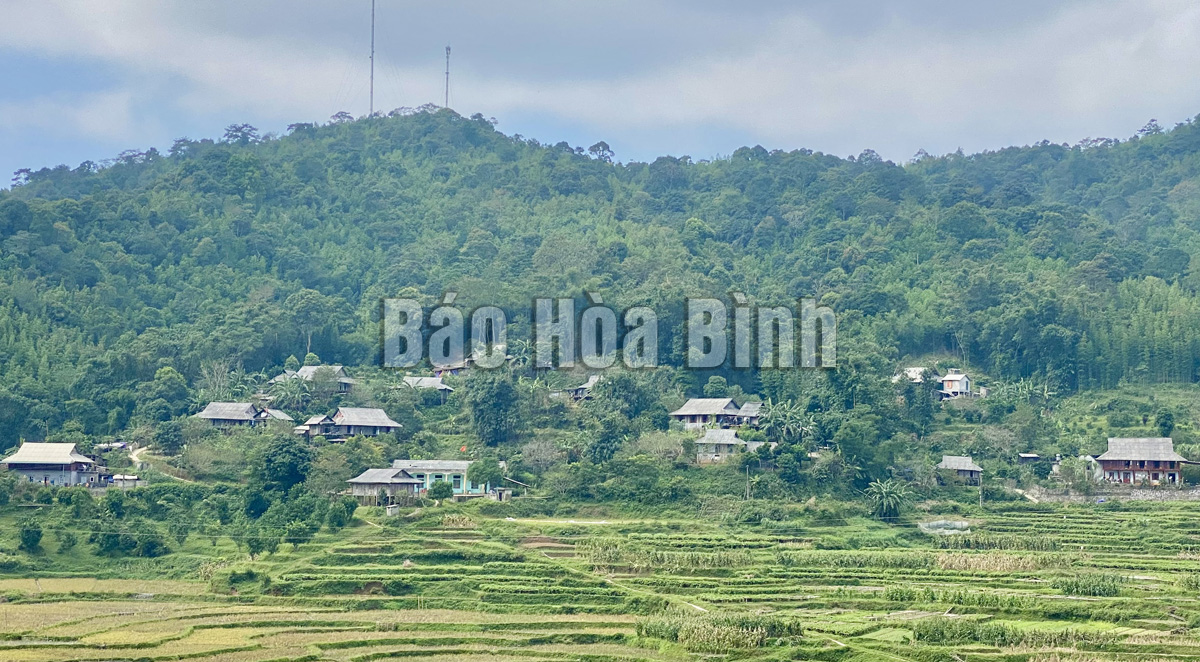
(HBO) - Boasting diverse natural and cultural tourism resources, the three highland communes of Van Son, Quyet Chien, Ngo Luong in Tan Lac district are gradually exploiting their tourism potential and advantages. Recently, the province has issued a resolution and a plan on turning these localities into a provincial tourist area by 2030, with a vision to 2050.

A check-in point in terraced fields
of Lo village in Van Son commune.
Located at 800 - 1,000m above sea level and covered by the forest so the
weather in the above-mentioned communes is always cool in the summer. There are
many beautiful caves in the area, such as Nam Son Cave which is honoured as a
national relic. In addition, there are a number of places to visit and explore,
including Lung Van Peak, Lung Van terraced fields and Quyet Chien
chayotevalley.
The local community also preserves many cultural values associated with the
Muong ethnic identity. They have maintained their stilt houses, household
utensils, and traditional costumes. Many residential areas still preserve
traditional festivals, performances of Mo Muong
-apopularritual ceremony that has become theunique
cultural heritageof the Muong ethnic community in Thanh Hoa and many
otherprovinces in the northern mountainous region,folk songs and
games.
In addition to community-based tourism, the three communes also have the
potential to develop agricultural tourism with some typical agricultural
products namely Nam Son tangerines; off-season vegetables and fruits of Quyet
Chien commune and Shan Tuyet tea.
According to Dinh Son Tung, head of the district’s culture and information
division, despite being affected by the COVID-19 pandemic, its tourism
activities have achieved positive results. In 2019, it welcomed 10,000
tourists, including 3,000 visitors who stayed overnight, earning 2.5 billion
VND in revenue. Incomes from community-based tourism services has contributed
to improving people's living standards.
In order to develop tourism in a sustainable way and attract tourists, the
district will exploit the existing tourism potential while focusing on
preserving and promoting special cultural values as well as building unique and
attractive products. Priority will be given to the development of resorts,
ecological sites and community-based tourism.
It willfocus on mobilising resources and using investment from the State
and from organisations, businesses and individuals to develop tourism,
especially pouring capital into transport infrastructure at destinations and
inter-regional traffic connections.
The development of telecommunications technical infrastructure will be
promoted.
All economic sectors will be encouraged to invest in accommodation facilities,
restaurants, hotels, and recreation facilities.
Attention will be paid to afforestation, forest protection and building
attractive landscapes along roads and tourist attractions./.
Located just a 20-minute drive from Hoa Binh City, Ora Hill Farmstay & Glamping Hoa Binh is a captivating new destination nestled in Mo hamlet, Bình Thanh commune, Cao Phong district. Combining farming with leisure, this tranquil retreat is perfect for those seeking balance, joy, and an immersive experience in the expansive beauty of nature.
Muong Bi - Tan Lac is renowned as one of the four famous Muong regions in Hoa Binh province. Blessed by nature with a favourable climate and stunning landscapes, Tan Lac holds great advantages for tourism development. The local tourism industry has made remarkable strides in recent times thanks to the attention and support from the local authorities and sectors.
With its strategic location, well-developed transport network, and diverse soil and climatic conditions, Hoa Binh is emerging as a must-visit destination in Vietnam's northwestern tourism corridor. The province boasts numerous attractions, including the Kim Boi hot springs (Kim Boi district), the Dau Rong cave complex (Cao Phong), the Mai Chau valley (Mai Chau), and the iconic Hoa Binh hydropower plant.
The northern mountainous province of Hoa Binh has been listed among the 71 most beautiful places to visit worldwide by the prestigious US travel magazine Condé Nast Traveller.
Hoa Binh province’s rich natural and cultural resources position it as a prime location for developing community-based tourism (CBT). In recent years, support from central and provincial policies, as well as assistance from non-governmental organisations, have encouraged local ethnic minority and mountainous communities to actively engage in the sector.



